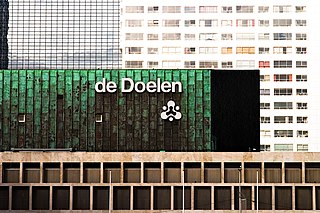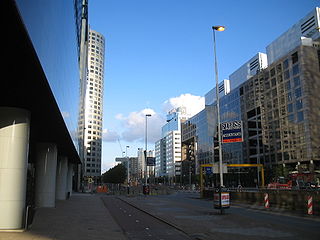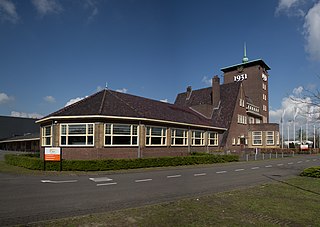
The Boezembrug is a bridge in Rotterdam, part of the Gouda Roadway. The Bosom bridge connects both banks of the Boezem. The bridge is a Rijksmonument designed by S. J. Rutgers in 1903.
51°55′43″N4°29′51″E / 51.9287°N 4.4974°E

The Boezembrug is a bridge in Rotterdam, part of the Gouda Roadway. The Bosom bridge connects both banks of the Boezem. The bridge is a Rijksmonument designed by S. J. Rutgers in 1903.
51°55′43″N4°29′51″E / 51.9287°N 4.4974°E

De Doelen is a concert venue and convention centre in Rotterdam, Netherlands. It was originally built in 1934 but then destroyed in 1940 during the German bombardment of Rotterdam in May 1940 at the outset of World War II. It was rebuilt in 1966, originally with one hall to which two more were added in the 1990s.
Gabberia is a census town in Panchla CD Block of Howrah Sadar subdivision in Howrah district in the state of West Bengal, India.

The Lijnbaan is the main shopping street of Rotterdam. It was opened in 1953, as the main pedestrian street in the new shopping district, after the old shopping district was completely destroyed during the bombing of Rotterdam by the German Luftwaffe. It was designed by the firm Van den Broek & Bakema led by architects Jo van den Broek and Jacob B. Bakema. It was the first purpose-built pedestrian street in Europe.

Fordingbridge was a railway station serving Fordingbridge, a small town in Hampshire. It was one of many casualties of the mass closure of British railway lines in the 1960s and 1970s. The line was officially closed on 4 May 1964, but as there was no Sunday service the last trains ran on the 2nd. It was served by the Salisbury and Dorset Junction Railway, a line running north–south, along the River Avon just to the west of the New Forest, connecting Salisbury to the North and Poole to the south, meeting the Southampton and Dorchester Railway at West Moors.

Bermondsey Square is on Tower Bridge Road in Bermondsey, south London, England. It was the site of the 11th-century Bermondsey Abbey. The earliest medieval remains found are a Norman church from around 1080, which was recorded in the Domesday Book of 1086. The Abbey grounds were the original site of Bermondsey Market, which still takes place weekly in the Square. The area has subsequently undergone redevelopment and Bermondsey Square now contains apartments, offices, a boutique hotel, restaurants, an independent cinema, and a contemporary art gallery.

The Witte Huis or White House is a building and National Heritage Site in Rotterdam, Netherlands, built in 1898 in the Art Nouveau style. The building is 43 m (141 ft) tall, with 10 floors. It was also the first hoogbouw in Europe. The building is listed as a Rijksmonument.

The former Van Nelle Factory on the Schie in Rotterdam, is considered a prime example of the International Style based upon constructivist architecture. It has been a designated UNESCO World Heritage Site since 2014. Soon after it was built, prominent architects described the factory as "the most beautiful spectacle of the modern age" and "a poem in steel and glass".

Post mill Rosmalen is a post mill in Rosmalen, Netherlands. The mill is situated in the neighbourhood of Molenhoek. The mill was built in 1732 on a natural slope. This slope is accented with old millstones.

Atlantic Huis is a business complex in the Maritime Quarter in Rotterdam. The house is opposite the Veerhaven.

The Berg en Broeksche Verlaat is a canal lock in Rotterdam between the River Rotte and 2 peat bogs. It was built in 1866 and has Rijksmonument status.

The Boterdorpse Verlaat is a lock between the River Rotte and Strekvaart in Bergse Plassen in the municipality of Rotterdam. [1] The fairway was formerly used by vessels carrying malt wastes from Schiedam but nowadays is very rarely used even for pleasure.

Spangen is a neighborhood of Rotterdam, Netherlands.

The City Hall in Dordrecht is a renaissance building decorated in neoclassic style on the Stadhuisplein and over one of the city harbors; the Voorstraathaven. It is the seat of the city's government, which first received city rights in 1220, and today it is still the place where residents often hold their civic wedding ceremonies.

Reimerswaal is a lost city in the Netherlands. The present-day municipality of Reimerswaal is named after this city, which was granted city rights in 1374. The city was destroyed by repeated floods, and the last citizens left in 1632. Nothing remains. It was located north of the current municipality, on the east end of the Oosterschelde, on land which is now called the Verdronken Land van Reimerswaal. The site of the city has been recognized as a national archeological monument and is buried under the Oesterdam.

Weena is a street with many highrises in the center of Rotterdam, Netherlands. It defines the Rotterdam skyline. The street of about 1 kilometer length leads east-west from Hofplein to Beukelsdijk.
Megchelen is a village in the Dutch province of Gelderland. It is a tiny hook of land surrounded on three sides by the German border in the municipality of Oude IJsselstreek, about 7 km southeast of the town of Ulft on the Zwanenburgseweg.

Baden Powelllaan 12 is an old house (Heerenhuis) in Het Park, Rotterdam, built circa 1760. Found near the Euromast it was the main building of the De Heuvel estate. From 1875 this villa forms part of the Park. The mansion reflects the late 18th century Dutch grandeur It is classified as a Rijksmonument.

The De Hoed Mill is a post mill in Waarde, Netherlands. The structure was originally built as an oil mill in the town of Ghent in 1550, and was converted to a corn mill in the late 17th century. The mill was moved to its current location in 1989.

The Destroyed City is a bronze memorial sculpture in the Dutch city of Rotterdam. It commemorates the German bombing of Rotterdam on 14 May 1940, which destroyed the medieval centre of the city. Unveiled in 1953, it was designated as a Dutch national monument (Rijksmonument) in 2010. It is the largest sculpture by the Russian-born French sculptor Ossip Zadkine, his best known work, and the best known sculpture in Rotterdam.

The Brabanthallen is a convention center in 's-Hertogenbosch, Netherlands. Every year, it hosts several exhibitions, conferences, trade fairs, concerts and other big events. It is the third largest convention center in the Netherlands, after RAI Amsterdam and Jaarbeurs Utrecht.